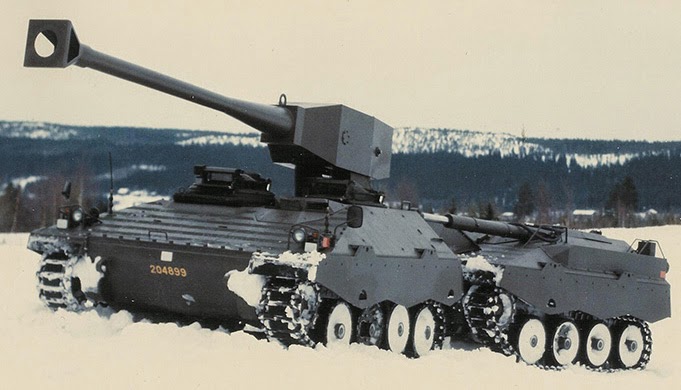The Strv m/47 In Swedish Service, Initial History
The Swedish Army performed several minor modifications to their Sherman Vs upon receiving them in September 1947: these included fitting of a Swedish radio, metric instruments, and other very minor changes. However, the main and secondary armament of the tank, as well as major systems such as the powertrain remained unchanged. Fortunately, both the M2 and M1919 machine guns used on the Strv m/47 were already in Swedish military service.
Swedish tank crews immediately took a liking to the Sherman. The tanks were reliable and easy to maintain, while the thicker armor (compared to the Strv m/42) gave the crews confidence (the reliability was even more appreciated by Swedish mechanics). The tanks were also easy to drive, allowing soldiers to adjust to it quickly from other tanks in the Swedish Army.
The addition of 50 modern tanks to the Swedish Army was a sizable increase, and allowed for some reorganization. The old, machine-gun armed Strv m/37s on Gotland were finally retired from front-line service; some were sent to training units, while a few were dug-in as pillboxes. They were replaced by L-60s (Strv m/38,m/39,m/40) still in service, along with some Strv m/41s (the two units that received the Strv m/47 actually converted from m/41s). For the time being, the Strv m/42s were kept in front-line armored units, along with the Strv m/47. Fifty tanks was obviously not enough to replace the more than 200 Strv m/42s built, and in any case, the m/42 was still decently capable.
This is not to say that there were not some challenges. The tracks on the Strv m/47 proved to have difficulty in ice and snow, and by 1949 were soon replaced by a new track of Swedish design. A much larger difficulty was caused by the tank's weight. The Strv m/42, previously the heaviest tank in Swedish service, weighed about 22 tons, maybe a bit more if fully loaded with a squad of infantry riding on the back. Many other armored vehicles, like the m/41 or Sav m/43 weighed 12 tons or less. Meanwhile, the Strv m/47 tipped the scales at about 35 tons! This had been one of the main worries about adoption of the Strv m/47, and there were some problems. While most roads were able to handle the tank's weight, several bridges were not. On exercises in 1948 and 1949, there were multiple instances where the m/47s had to ford a river or take a longer route while the lighter m/41s and m/42s were able to head directly to the destination. However, it turned out that these difficulties were not insurmountable. The tank had solid off-road capabilities, and was still light enough to be easily moved by rail or ferry. The Army was able to use to issue to get a few bridge upgrades in key areas attached to government budgets in the late 1940s, which helped alleviate the issue while improving Swedish infrastructure in general. Admittedly, a good chunk of the infrastructure development in the 1940s and 1950s was funded by the long postwar Swedish economic boom, so the Army's role is perhaps overstated. Also, the issues encountered did give army planners and tank crews experience with operating heavier vehicles; this would prove to have significant influences on Swedish armored vehicle development in the coming years.
While the overall design of the Strv m/47 was felt to be excellent, Swedish engineers and military experts did identify some areas for improvement. The first was the gun. The 75mm M3, while well liked for its good high explosive round, had insufficient anti-tank performance to deal with the latest Soviet threats, and was marginal against even the T-34 (especially at range). There had already been thoughts of rearming the Strv m/42; the Strv m/47 with its larger turret was deemed an even better candidate for upgunning. This would soon result in the development of the Strv m/49, the first of the improved Swedish Sherman variants.
The other flaws were deeper in the design. The combination of a rear engine and front drive meant that a driveshaft ran along the bottom of the tank, increasing the height, which made the tank a larger target and heavier (the taller the tank, the greater the weight of armor needed to give equivalent protection). Swedish engineers felt this was a significant flaw, and one that would have to be fixed in any future design. The suspension was felt to be a bit outdated in construction, though adequate. Additionally, the sponsons were felt not to be very useful, though this was not a major issue. These lessons would be incorporated into future Swedish tank designs of the 1950s.
***
Background: The "Swedish Impressions of the Sherman" articles again. This article on the Sherman Tank Site;
http://www.theshermantank.com/sherm...hat-was-wrong-with-the-tank-and-stayed-wrong/ gives a bit of a primer on some of the issues with the M4's design. This Soviet pen chart;
http://3.bp.blogspot.com/-u9VFDPfmDeA/UDSiC2YRXVI/AAAAAAAABAw/LhaZy328zxs/s1600/pen.jpg shows how much the 75mm M3 had fallen behind other guns in armor penetration. This article from 1941;
http://tanks.mod16.org/2014/01/10/minutes-of-meeting-1941-04-30-regarding-development-of-new-afvs/ talks about development of the Strv m/42 and discusses the weight concerns. There was originally a maximum weight of 20 tons for the design, the m/42 went a bit over, but this was still light compared to the M4 or T-34. With that said, the Swedish Army bought Centurions OTL, which are HUGE compared to the m/42, and even the M4, so using a 35 ton tank in Sweden obviously wasn't an impossibility (though I'm not sure of what difficulties the Centurion/Strv 81 encountered with Swedish roads, for all I know a bunch fell into a river a month after delivery after trying to drive over an old bridge).
